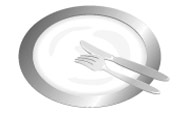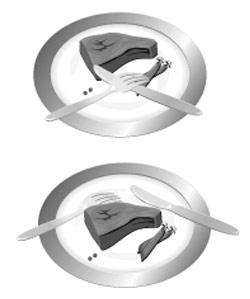A lipstick trail is the red badge of discourtesy. Take precautions before you reach the table. This is also the time to visit the restroom for hair repair and other finishing touches. Remember to greet everyone before sitting down. Gentlemen must rise to greet latecomers. They may also rise when ladies leave and return to the table, although today’s woman should not expect this behavior. A server will draw the chair for you. Enter from your left. After you are seated, wait for your host to make the first napkin move. When the host places the napkin on his or her lap, the guests should follow suit. Similarly, at the end of the meal, the host should be the first to place the napkin on the table to signal that the meal is over, having made certain that everyone at the table has finished. Large dinner napkins should remain folded in half and placed across your lap with the fold facing your waist. Never “flap” the napkin to unfold it. If you leave the table during the meal, place the napkin on your chair. If the server does not push the chair back under the table, you should do so. The server may also refold your napkin and place it on the arm of your chair during your absence. At the end of the meal, do not refold the napkin. Pick it up from its center and place it loosely on the table to the left of your plate. Wine will be served during a formal dinner. If you don’t want wine, place your fingertips lightly on the rim of the glass when the server approaches to pour. (Never turn your glass upside down.) Say, “I’m not having any today” (or this evening or tonight). The today sends a message: You don’t disapprove of wine, and the others should feel no compunction about enjoying their wine if they choose. Wine is offered with the first course (soup) and will be poured from the right. Red wine (and brandy) glasses are held by the bowl because the warmth of the hand releases the bouquet. Red wine glasses may also be held by the stem, but white wine and champagne glasses are always held by the stem, so as not to diminish the chill. Wait until your host has lifted his or her glass before you drink. Once again, the number of pieces of silverware will indicate the number of courses you can expect, and the general rule is to start from the outside. You may expect the formal dinner to consist of seven courses, in this order: soup, fish, sorbet (or other palate cleanser), a meat or fowl dish, salad (often served with cheese), dessert, and coffee. Courses are served from the left, removed from the right. Wine is poured from the right. (It helps to know from which direction they will be coming at you.) Try to finish each course at about the same time as others around you. When you are finished with a course, hoist out the “I am finished” pennant. Here’s how: Visualize a clock face on your plate. Place both the knife and fork in about the 10:20 position with the points at 10 and the handles at 20. The prongs of the fork should be down, and the blade of the knife should face you. If you have been eating the course with the fork only, place it prongs up in the same position as the knife when finished. Placing flatware in the finished position facilitates the server clearing from the right. He or she can secure the handles with the thumb, thus reducing the risk of dropping them in the diner’s lap. Hoist out the “I am resting” pennant when you want to pause during a course and don’t want the server to snatch your plate away. In this case, the knife and fork are crossed on the plate with the fork over the knife and the prongs pointing down. The knife should be in the 10:20 position, as on the face of a clock; the fork prongs should be at two o’clock, and the handle at eight o’clock, forming an inverted V. It is also correct to form the inverted V without crossing fork over knife. Servers in fine restaurants are usually trained to recognize the I-am-finished and the I-am-resting signals. Now let’s look at how to deal with each course.

